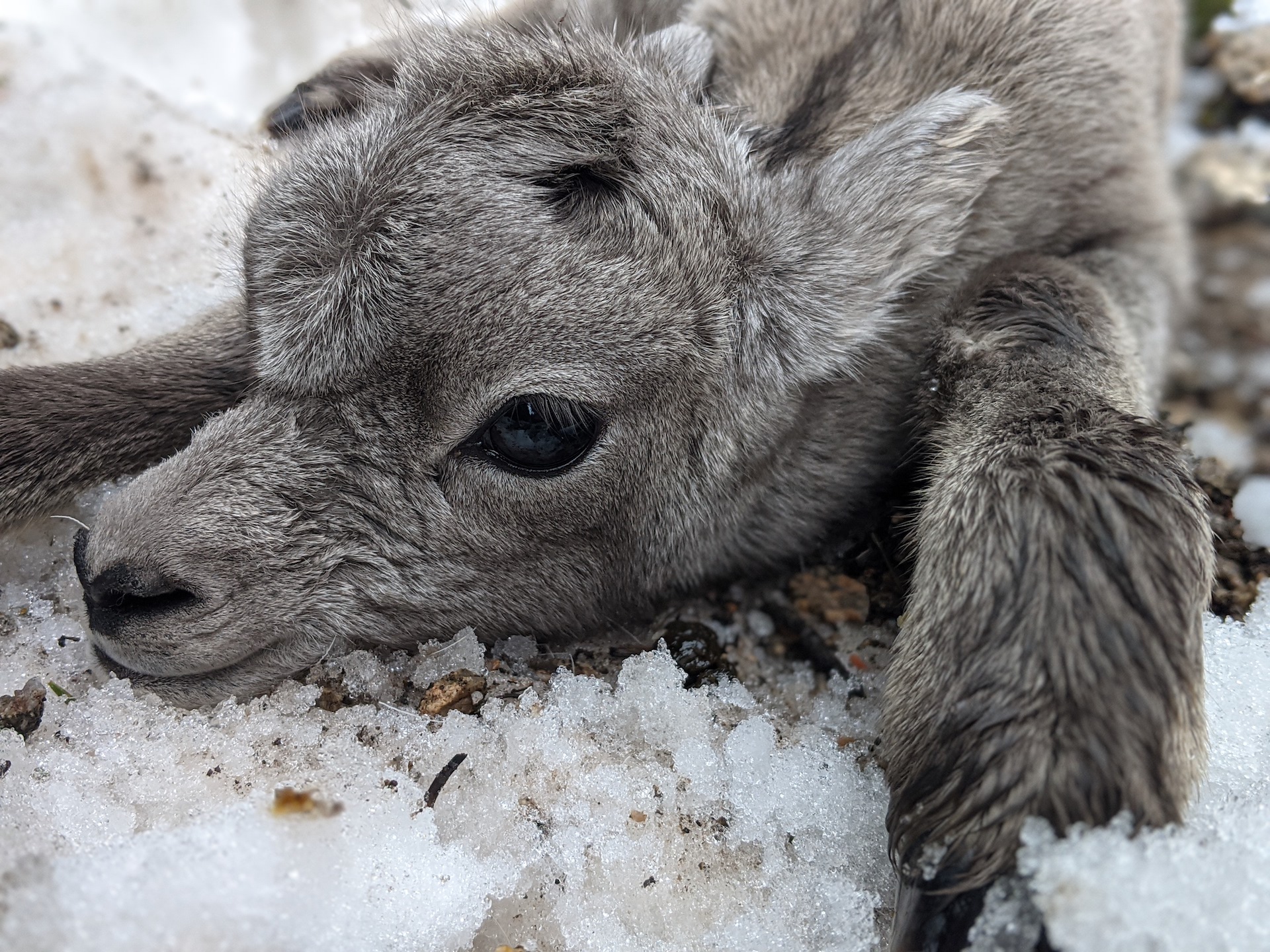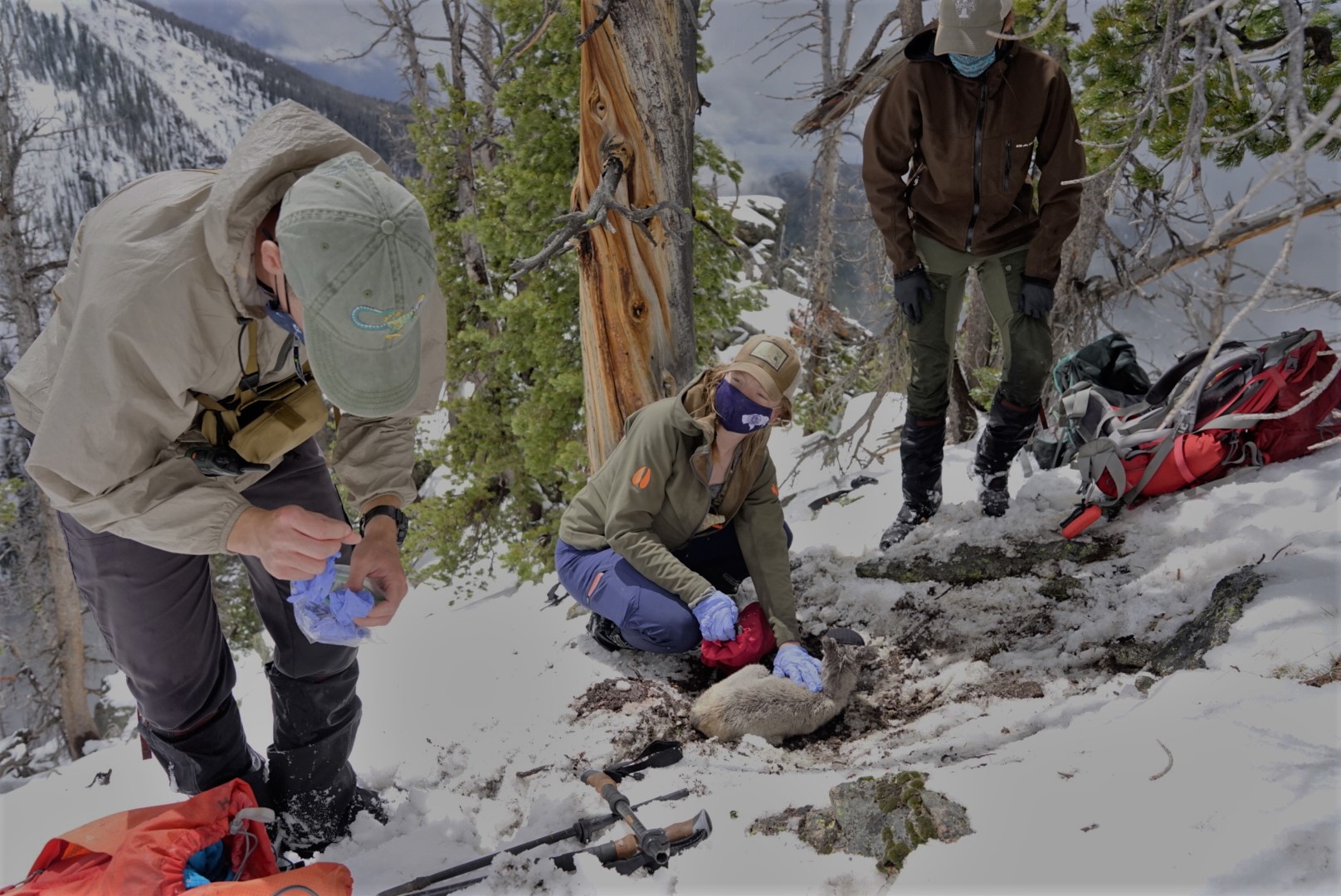
High in the rocky cirques of Wyoming’s Wind River Range, Rachel Smiley and Brittany Wagler research sheep—bighorns, that is. Armed with only hiking boots and binos, the pair and their research techs seek to locate and capture hours-old lambs in alpine cliff bands and scree fields as part of a project studying a precipitous decline in the herd’s population.
The short scoop is that Wind River bighorns aren’t doing well. In 1991, the local “Whiskey Mountain” herd experienced a pneumonia epizootic, or disease outbreak, that was followed by decades of low juvenile survival. In recent years, juvenile survival rates have fluctuated between 20% on the high end, and single digits on the low end. That’s a recipe for a declining population. Together, the original outbreak and low recruitment have left the herd at around 300 animals—a fraction of its former 1,500.
Smiley and Wagler’s research project, through the Monteith Shop, led by Dr. Kevin Monteith, at the University of Wyoming, aims to determine why the population has failed to rebound in the 30 years since the initial epizootic. To do so, their effort is two-fold: assess the survival of newborn lambs, and determine the quality and availability of forage in the sheep’s summer range.

Capturing Lambs
To address their first objective, the researchers capture newborn lambs, collecting basic body measurements and testing for the presence of pneumonia-causing pathogens. Surprisingly, the only way to capture the lambs off their harsh alpine lambing grounds is by hand every May and June.
The researchers are notified of a birth by a “ping” from a vaginal transmitter tag, which falls out with a newborn lamb (the tags are implanted into pregnant ewes on their winter range in March). Then the footrace begins. The researchers hike deep into the mountains—some of the most rugged terrain in the West. It’s paramount that the team captures lambs within about 24 hours of birth. After that, the sheep are already agile enough to outrun a person in the steep cliffs.
“It’s insane how capable they are,” Smiley said. “We’ve seen 12-hour-old lambs jump straight up cliffs. A one-day-old lamb can outrun us.” And so, it’s a matter of stealth and strategy to get in close for a successful capture. Akin to bowhunting, only more intimate, Smiley and Wagler try to sneak up on the animals without being detected. If the sheep notice them approaching, the chances of getting near enough to capture a lamb decrease dramatically.
Once the researchers get their hands on a lamb, they weigh it and collect a small blood sample to test for absorption of colostrum—supercharged milk produced by mammals in the first hours or days after giving birth. They also put a radio collar on the animal, so they can track its movement and subsequent survival.
During one of these captures, the mother sometimes stands off to the side, watching the proceedings unfold. Based on radio collar data, the ewe and lamb typically reunite within a few hours.
Tracking the lambs after birth, the researchers have found that over the first two weeks, most mortalities are due to predation or accidents such as falling off cliffs or getting feet stuck in cracks. Once the sheep make it through a couple weeks of life, however, the main cause of death appears to be pneumonia.

Food for Thought
Adding to the mystery of the Whiskey Mountain herd’s decline is that neighboring sheep populations—including the Jackson herd just 150 miles west—are equally as exposed to pneumonia, but don’t appear to be dying in droves as a result. The researchers suspect that forage quality could be responsible for the discrepancy. To test their hypothesis, they sampled vegetation in the sheep’s alpine summer ranges.
For every collared sheep in their study, the researchers generated ten points from the animals' GPS data within the animal’s summer “home range” to conduct vegetation samples. The idea sounded great on paper, but in the field proved to be more challenging. “A lot of the time we couldn’t actually get to the points,” Wagler said. “And other times, there wasn’t even vegetation present.” In other words, the Wind River sheep are living in alpine environments sometimes devoid of food.
The Jackson side was a different story. “We found that Jackson had a higher species diversity and more biomass,” Wagler said. In short, there’s just more food for the Jackson herd to eat and animals in Jackson have easier access to nutritious forage.
In all, a bigger picture is starting to come into focus. From a biological standpoint, there are energetic tradeoffs between survival, reproduction, and immune function. In the Jackson herd, there’s enough food (energy) to successfully do all three. In the Wind Rivers, however, forage quantity and quality are limited, resulting in some kind of energetic compromise. That means sheep likely don’t have enough energy to put into immunity, surviving, and reproducing, and as a result the lambs may have weaker immune systems, making them more susceptible to pneumonia.
After thirty years of depressed lamb survival, there doesn’t appear to be an easy solution. On the management side of things, the Wyoming Game and Fish Department created a plan for the Whiskey Mountain herd in 2019, highlighting measures to potentially capture or kill “clinically ill” bighorn sheep, as well as to isolate sheep populations from other sources of disease, such as nearby mountain goats. There might not be a silver-bullet solution, but it’s a game of numbers with a herd in decline.

Images via Rachel Smiley and Brittany Wagler.





Conversation